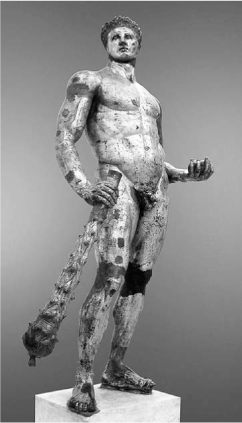Classical Greek MythologyHerakles and the Twelve Labors |
What is the myth of Herakles? |
Herakles’s (Roman name, Hercules) conception story makes use of a theme used later by the compilers of the King Arthur myth—conception via lover disguised as husband. As the story goes, Zeus desired Alkmene, the daughter of the King of Mycenae, who was living in Thebes with her husband Amphitryon. In order to achieve his goal, Zeus disguised himself as Amphitryon while the latter was away on a mission. Zeus and Alkmene spent a night of passionate love-making, which the couple enjoyed so much that Zeus extended the one night to the equivalent in length of three. When Amphitryon returned, he, too, slept with Alkmene. In time Alkmene gave birth to twins: Herakles was the son of Zeus, Iphikles the son of Amphitryon. As usual, Zeus’s “disguise” was not sufficient to fool his jealous wife Hera, who now dedicated herself to revenge by making life difficult for Herakles. She began by sending serpents to kill him in his cradle when he was eight months old. Herakles demonstrated his heroic qualities for the first time by strangling the serpents—one in each hand. As Herakles grew up he became stronger and stronger and accomplished many heroic deeds and sexual conquests. But Hera’s hatred of Zeus’s son remained strong. Herakles had married Megara, a princess of Thebes, who gave birth to his three children. Hera caused the hero to go insane and to kill his children and the children of his brother Iphikles. Some say he also killed Megara. Emerging from his madness, Herakles, in despair, sought advice from Apollo’s priestess at Delphi, who advised him to move to Tiryns to serve King Eurytheus for twelve years.
It is the “twelve labors” assigned by Eurytheus that made Herakles the greatest of the Greek heroes.

Herakles (sometimes better known as by his Roman name, Hercules) is depicted here in a guilded bronze Roman statue from the second century B.C.E.
